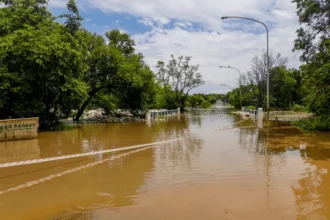The federal government closure 2025 update shows that the nation remains in a partial shutdown, marking the longest funding lapse in U.S. history. After weeks of political deadlock, the Senate approved a bipartisan funding bill with a 60-40 vote. Eight Democrats joined all Republicans to advance the measure. The bill now moves to the House of Representatives for a final vote.
- Impact of the U.S. Government Shutdown on Americans
- U.S. Government Shutdown Senate Vote and Congressional Deal
- History of the U.S. Government Shutdown
- Timeline of the U.S. Government Shutdown 2025
- Economic and Social Consequences of the U.S. Government Shutdown
- Federal Workers and Military Challenges During the U.S. Government Shutdown
- Future Implications of the U.S. Government Shutdown
- Conclusion: The U.S. Government Shutdown Update Today
The legislation funds most federal agencies through January 30, 2026, and continues key programs including SNAP, veterans’ benefits, and operations at the USDA, FDA, and the legislative branch. The agreement prevents additional layoffs until the end of January and guarantees back pay for employees who missed paychecks during the closure.
Despite this progress, the legislation does not immediately extend expiring ACA subsidies, a key Democratic demand. Senate Majority Leader John Thune has promised a future vote on healthcare tax credits, leaving the federal shutdown status fragile. Millions of Americans continue to experience service disruptions, and air traffic operations remain strained, highlighting the wide impact of the funding impasse.
Impact of the U.S. Government Shutdown on Americans
Federal Employees and Pay Disruptions
The federal funding lapse is most visible for federal employees. Approximately 1.4 million civilians are affected. Half are furloughed, meaning they are not working and are not receiving pay during the shutdown, though they are legally entitled to back pay once government operations resume. The remaining half, considered essential, continues working under high stress and uncertainty.
Certain agencies, like the Department of Veterans Affairs, have funding outside annual congressional appropriations, so some employees continue to be paid. For most others, missed paychecks create financial hardship. The uncertainty surrounding shutdowns adds additional pressure, illustrating how prolonged federal funding deadlocks directly impact daily life. Visit our homepage for more information.
Military Operations and Pay Challenges
Government funding deadlock: military pay has been a critical concern. The Department of Defense redirected funds from housing, research, and development accounts to ensure active-duty members receive paychecks. Military families are struggling to cover bills, though emergency allocations have helped prevent a total disruption.
The National Nuclear Security Administration furloughed some staff while maintaining essential operations. Contractors dependent on federal funding have also faced delays, showing the broad impact of the federal operations halt on national security.
Low-Income Families and Social Programs
Millions of Americans relying on social programs have been directly affected. SNAP benefits, which provide roughly $8 billion per month for groceries, were temporarily halted but partially restored using emergency funds. WIC programs, supporting nutrition and health services for 7 million women and children, face funding challenges as emergency resources deplete.
Head Start programs have been closed in certain states, affecting thousands of children who rely on early learning, meals, and health screenings. The federal shutdown has disrupted services that families depend on for childcare and nutrition.
Travel and Transportation Impacts
Air travel has been heavily affected by the federal shutdown. Staffing shortages among unpaid air traffic controllers led to cancellations and delays at major airports, including Atlanta, Newark, San Francisco, New York, and Chicago.
The Thanksgiving season is expected to face major travel disruptions if the closure continues, highlighting the economic ripple effects. Shipping and tourism are also affected, illustrating the far-reaching consequences of the government’s operations.
U.S. Government Shutdown Senate Vote and Congressional Deal
Breaking the Deadlock
The US government shutdown Senate vote represented a turning point. Eight Democratic senators broke ranks with their party to join Republicans and approve the bill. These senators were Jeanne Shaheen, Dick Durbin, Tim Kaine, Maggie Hassan, Angus King, Jacky Rosen, Catherine Cortez Masto, and John Fetterman.
Each senator cited the urgent need to reopen federal operations and protect workers, food assistance, and critical services. Shaheen emphasized that reopening was necessary to negotiate ACA subsidies. Durbin highlighted full funding for SNAP and reversing layoffs. Kaine described the agreement as a “moratorium on mischief,” preventing further mass firings. Rosen and Cortez Masto cited economic impacts on tourism and travel, while Fetterman criticized the use of the shutdown as a bargaining tool for healthcare concessions.
Trump and Japan Critical Minerals Deal Strengthens Supply Chain
Provisions of the Funding Deal
The legislation funds agencies through January 30, 2026, protects federal employees from layoffs, and guarantees back pay. While ACA subsidies are not extended immediately, a future vote is promised. Programs like SNAP, WIC, and veterans’ benefits are temporarily funded.
The compromise illustrates the delicate balance of political priorities and public needs, showing how federal funding lapses can impact millions of Americans.
History of the U.S. Government Shutdown
Past Shutdowns and Frequency
The U.S. government shutdown history shows that funding gaps are recurring. Since 1976, there have been 20 federal funding gaps and 10 full shutdowns. These have ranged from a single day to over a month. The last U.S. government shutdown occurred in 2022, and the 2020 shutdown also reflected partisan gridlock.
Shutdowns often arise from disagreements over healthcare, defense, and social spending. The current closure began on October 1, 2025, primarily over ACA subsidies and broader fiscal disputes between Republicans and Democrats.
Comparisons to Previous Shutdowns
Earlier shutdowns disrupted services and delayed federal employee pay, but the 2025 closure is unprecedented in length. The current longest government shutdown illustrates how extended funding gaps amplify impacts on low-income families, federal workers, and national security.
Historical patterns show shutdowns disproportionately affect vulnerable populations, emphasizing the need for long-term reforms to prevent future disruptions.
Timeline of the U.S. Government Shutdown 2025
Start of the Shutdown
The U.S. government shutdown date was October 1, 2025, after the Senate failed to pass a budget agreement. Multiple funding proposals failed, largely due to disagreements over ACA subsidies and broader spending priorities.
Senate Breakthrough
In early November, moderate Democrats negotiated with Republicans, resulting in a Senate vote of 60-40. While the legislation temporarily restores government operations, ACA subsidies remain unresolved.
House and Presidential Action
The House of Representatives is expected to vote shortly on the measure. If approved, it will go to the president for signature, ending the partial closure and ensuring back pay for federal employees. Programs such as SNAP, WIC, and Head Start will resume normal operations once funding is restored.
Economic and Social Consequences of the U.S. Government Shutdown
Impact on Federal Programs
The government funding deadlock update highlights the disruption of essential services. SNAP and WIC programs continue partially, while Head Start closures leave children without early learning, meals, and screenings.
Travel Disruptions and Economic Impact
Air travel cancellations and delays affect airports nationwide, creating disruptions in business travel, tourism, and shipping. Local economies experience reduced tax revenues and increased strain, showing how federal operations halt impacts broader communities.
Financial Market Volatility
Markets have shown sensitivity to federal uncertainty. The US government shutdown S&P reflects investor concerns over prolonged budget disputes. ACA subsidies remain unresolved, impacting millions of Americans and potentially raising insurance premiums in 2026.
Federal Workers and Military Challenges During the U.S. Government Shutdown
Employee Pay and Furloughs
Furloughed employees are waiting for back pay while essential workers continue under stress. Emergency funds have been moved to partially cover active-duty military and law enforcement officers.
National Security and Operations
National Nuclear Security Administration furloughs reduce staff, though essential oversight continues. National Parks and Smithsonian facilities operate with limited services, maintaining animal care while reducing public access and information updates.
Future Implications of the U.S. Government Shutdown
Healthcare and ACA Subsidies
The extension of ACA subsidies remains a key unresolved issue. While the bill temporarily restores operations, millions face uncertainty regarding healthcare costs in 2026.
Lessons from Past Shutdowns
The U.S. government shutdown over history illustrates the human, economic, and social costs of prolonged funding gaps. The 2025 closure highlights the importance of bipartisan compromise to ensure continuity of services, protect federal employees, and maintain public trust.
Preventing Future Shutdowns
Historical patterns and the current 2025 closure provide lessons for avoiding future crises. Legislative reforms, contingency planning, and timely negotiation can reduce human and economic costs and ensure government services remain accessible.
Conclusion: The U.S. Government Shutdown Update Today
The U.S. government shutdown update today underscores the broad consequences of federal funding disputes. Millions of Americans experience service disruptions, federal employees face pay uncertainty, and social programs are partially halted.
The 2025 shutdown, now the longest in U.S. history, demonstrates the need for long-term solutions. Bipartisan compromise is essential to restore government functionality and protect social and economic stability. End of government shutdown near as Senate passes funding deal
FAQs
- Why has the U.S. government shut down in 2025?
The 2025 shutdown occurred due to a budget impasse between Democrats and Republicans, primarily over expiring healthcare subsidies under the Affordable Care Act and broader federal spending priorities. - Can I still get my passport with the government shut down?
Routine passport services may be delayed, but emergency passport requests for urgent travel are usually still processed. - Why did Obama shut down the government?
During Obama’s administration, the government shutdowns (notably in 2013) were caused by disagreements over funding the Affordable Care Act and the federal budget. - Do I still get Social Security if the government shuts down?
Yes, Social Security benefits continue during a shutdown, but employees at Social Security offices may have limited services or slower processing.








